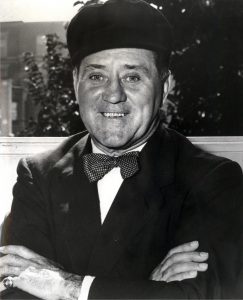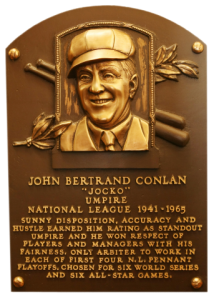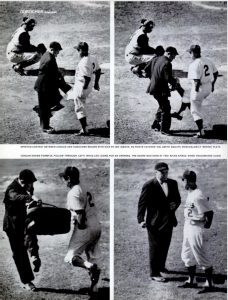If you wore a polka dot bow tie to work every day, people might have some opinions about you. If you were a Major League umpire, they might have even crazier thoughts.  John Bertrand “Jocko” Conlan wore such a bow tie and made himself into a Hall of Fame umpire. Before his 24 years as a Major League arbiter, Conlan fought his way through the minor leagues to play two seasons in The Bigs before fate would lead him down a different path.
John Bertrand “Jocko” Conlan wore such a bow tie and made himself into a Hall of Fame umpire. Before his 24 years as a Major League arbiter, Conlan fought his way through the minor leagues to play two seasons in The Bigs before fate would lead him down a different path.
Before Conlan made it to the National League as an umpire, he played two seasons in the American League, with his hometown Chicago White Sox. It was a long journey through the minor leagues for Jocko, filled with mistakes and bad luck. Conlan started his professional baseball career in 1920 in Wichita. Over twelve seasons, he bounced around, mainly at the AA level, also playing in Rochester, Newark, Toledo, and Montreal. Jocko was a career .300 minor league hitter, with his best season coming in 1924 when hit hit .321 with 12 home runs. Conlan probably would have made his Big League debut in 1925 for the Cincinnati Reds, but a late season injury nixed a trade and his opportunity was lost. He wouldn’t make the Majors until he was 34 years old.
Jocko Conlan’s luck changed in 1935. On July 28th, a 114 degree day, Conlan was out with an injury. He was asked to fill in for Red Ormsby, who was overcome by the heat. In those days, Major League games were officiated by 2-man crews. If an umpire wasn’t able to work, it was common practice to have a player or assistant coach help umpire the game. This is what Jocko Conlan did on July 28th and 29th in Chicago. Apparently, Conlan made a good showing during this opportunity, because after the White Sox released him at the end of the season, the team general manager recommended to him that he try his hand as an umpire. In those days, umpires had a pension system, unlike ball players, so Conlan was intrigued. After gaining experience in the minor leagues, Conlan made it to the National League as an umpire in 1941. He’d be there until 1965. During his tenure, he worked four NL playoffs, six World Series, and six All-Star Games. Jocko Conlan was elected to the Baseball Hall of Fame in 1974 as an umpire.
| I | Split | G | GS | PA | AB | R | H | 2B | 3B | HR | RBI | SB | CS | BB | SO | BA | OBP | SLG | OPS | HBP |
|---|---|---|---|---|---|---|---|---|---|---|---|---|---|---|---|---|---|---|---|---|
| 1935 Totals | 65 | 30 | 162 | 140 | 20 | 40 | 7 | 1 | 0 | 15 | 3 | 3 | 14 | 6 | .286 | .355 | .350 | .705 | 1 |
Jocko Conlan’s final APBA card is average…and that’s probably why he decided to become an umpire. Only starting 30 games, Conlan was a platoon player who was primarily used as a pinch runner and pinch hitter. He managed to hit a respectable .286. However, APBA seemed to short change him a bit with this card. My analysis has it only producing a .266 average. It would be helped if it had an extra 8 or 9. It would then produce a .290 average. However, I’m not sure where APBA would put an extra 8 or 9. Considering he only had 162 plate appearances, it was probably best for APBA to produce a conservative card for Conlan. Overall, this is a solid card. If I were doing a 1935 replay, I could see myself using it as a pinch hitter from time to time.
 As an amateur umpire, I take great interest in the all-time great arbiters, especially those who played in the Big Leagues. Jocko Conlan is particularly inspiring. He was about the same size as me. In today’s umpiring world, it seems like every umpire is 6-2 190. Conlan worked hard to gain the respect needed to run a ballgame. He wasn’t given respect because he was physically imposing. He earned it. He also did things his way. Originally, he thought he was going to be an AL umpire, so he used the balloon chest protector. He would be the last NL umpire to use the ballon protector because he thought it gave him better protection. Conlan injured his shoulders several times. After Jocko retired, all NL umpires used the inside protector. Over the ensuing decades, the two leagues developed distinctive strike zones. The NL was a low stike league because of the inside protector and the increased ability to call strikes from the slot; the AL became a high stike league because of the balloon protector and a tendency to call pitches over the top of the catcher. Like so many things in baseball, umpiring has changed a great deal.
As an amateur umpire, I take great interest in the all-time great arbiters, especially those who played in the Big Leagues. Jocko Conlan is particularly inspiring. He was about the same size as me. In today’s umpiring world, it seems like every umpire is 6-2 190. Conlan worked hard to gain the respect needed to run a ballgame. He wasn’t given respect because he was physically imposing. He earned it. He also did things his way. Originally, he thought he was going to be an AL umpire, so he used the balloon chest protector. He would be the last NL umpire to use the ballon protector because he thought it gave him better protection. Conlan injured his shoulders several times. After Jocko retired, all NL umpires used the inside protector. Over the ensuing decades, the two leagues developed distinctive strike zones. The NL was a low stike league because of the inside protector and the increased ability to call strikes from the slot; the AL became a high stike league because of the balloon protector and a tendency to call pitches over the top of the catcher. Like so many things in baseball, umpiring has changed a great deal.  With the advent of umpire schools and then the joining of the two leagues into a single MLB Umpires Association, umpiring has become more uniform and consistent. Instant replay, in general, has been a good thing for baseball. However, one thing it’s reduced in the modern game are the number of umpire-manager arguments. Rarely do we see a manager blowing his top like Earl Weaver, Lou Piniella, or Sparky Anderson used to do. In Jocko Conlan’s day, he had classic run-ins with Leo Durocher. In their most memorable spat, Conlan felt Durocher kicked him in the chin while attempting to kick dirt at him. Instead of ejecting Durocher and walking away, Conlan simply returned a kick to Durocher’s shin. He figured he’d be hurting more since he wasn’t wearing shin guards. Boy, have times changed.
With the advent of umpire schools and then the joining of the two leagues into a single MLB Umpires Association, umpiring has become more uniform and consistent. Instant replay, in general, has been a good thing for baseball. However, one thing it’s reduced in the modern game are the number of umpire-manager arguments. Rarely do we see a manager blowing his top like Earl Weaver, Lou Piniella, or Sparky Anderson used to do. In Jocko Conlan’s day, he had classic run-ins with Leo Durocher. In their most memorable spat, Conlan felt Durocher kicked him in the chin while attempting to kick dirt at him. Instead of ejecting Durocher and walking away, Conlan simply returned a kick to Durocher’s shin. He figured he’d be hurting more since he wasn’t wearing shin guards. Boy, have times changed.




